
 Data Structure
Data Structure Networking
Networking RDBMS
RDBMS Operating System
Operating System Java
Java MS Excel
MS Excel iOS
iOS HTML
HTML CSS
CSS Android
Android Python
Python C Programming
C Programming C++
C++ C#
C# MongoDB
MongoDB MySQL
MySQL Javascript
Javascript PHP
PHP
- Selected Reading
- UPSC IAS Exams Notes
- Developer's Best Practices
- Questions and Answers
- Effective Resume Writing
- HR Interview Questions
- Computer Glossary
- Who is Who
How to Convert Text String to Proper Case with Exceptions in Excel?
Have you ever wondered if there is a way in Excel to automatically correct the case of strings in a sentence? It is possible to make it happen in Excel. This tutorial will help you understand how you can convert text strings to proper cases with exceptions in Excel. We can complete this task using the VBA application, as it can't be completed directly in Excel. When the letters of the words are in the correct case according to grammar, they are called "proper case."
Converting Text String to Proper Case with Exceptions in Excel
Here, we will first create the list of exceptions, then insert the VBA module and run it to complete the task. Let us look at a simple procedure for converting strings to proper case with exception in Excel.
Step 1
Let us consider an Excel sheet where the data sheet is similar to the data shown in the below image.
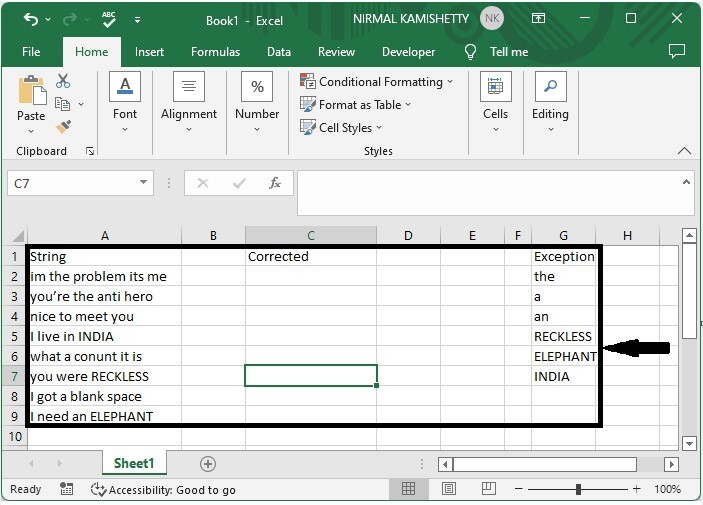
Then right-click on the sheet name and select View Code to open the VBA application. Then click on "Insert" and select "Module".
Right click > View code > Inset > Module
Step 2
Type the following program code in the textbox, as shown in the image below.
Program
Sub CellsValueChange()
'Update By Nirmal
Dim xSRg As Range
Dim xDRg As Range
Dim xPRg As Range
Dim xSRgArea As Range
Dim xRgVal As String
Dim xAddress As String
Dim I As Long
Dim K As Long
Dim KK As Long
On Error Resume Next
xAddress = Application.ActiveWindow.RangeSelection.Address
Set xSRg = Application.InputBox("Original cells:", "Proper Text String", xAddress, , , , , 8)
If xSRg Is Nothing Then Exit Sub
Set xDRg = Application.InputBox("Output cells:", "Proper Text String", , , , , , 8)
If xDRg Is Nothing Then Exit Sub
Set xPRg = Application.InputBox("Cells to exclude:", "Proper Text String", , , , , , 8)
If xPRg Is Nothing Then Exit Sub
Set xDRg = xDRg(1)
For I = 1 To xSRg.Areas.Count
Set xSRgArea = xSRg.Areas.Item(I)
For K = 1 To xSRgArea.Count
xRgVal = xSRgArea(K).Value
If Not IsNumeric(xRgVal) Then
xRgVal = CorrectCase(xRgVal, xPRg)
xDRg.Offset(KK).Value = xRgVal
End If
KK = KK + 1
Next
Next
End Sub
Function CorrectCase(ByVal xRgVal As String, ByVal xPRg As Range) As String
Dim xArrWords As Variant
Dim I As Integer
Dim xPointer As Integer
Dim xVal As String
xPointer = 1
xVal = xRgVal
xArrWords = WordsOf(xRgVal)
For I = 0 To UBound(xArrWords)
xPointer = InStr(xPointer, " " & xVal, " " & xArrWords(I))
Debug.Print xPointer
Mid(xVal, xPointer) = CorrectCaseOneWord(CStr(xArrWords(I)), xPRg)
Next I
CorrectCase = xVal
End Function
Function WordsOf(xRgVal As String) As Variant
Dim xDelimiters As Variant
Dim xArrRtn As Variant
xDelimiters = Array(",", ".", ";", ":", Chr(34), vbCr, vbLf)
For Each xEachDelimiter In xDelimiters
xRgVal = Application.WorksheetFunction.Substitute(xRgVal, xEachDelimiter, " ")
Next xEachDelimiter
xArrRtn = Split(Trim(xRgVal), " ")
WordsOf = xArrRtn
End Function
Function CorrectCaseOneWord(xArrWord As String, xERg As Range) As String
With xERg
If IsError(Application.Match(xArrWord, .Cells, 0)) Then
CorrectCaseOneWord = Application.Proper(xArrWord)
Else
CorrectCaseOneWord = Application.VLookup(xArrWord, .Cells, 1, 0)
End If
End With
End Function
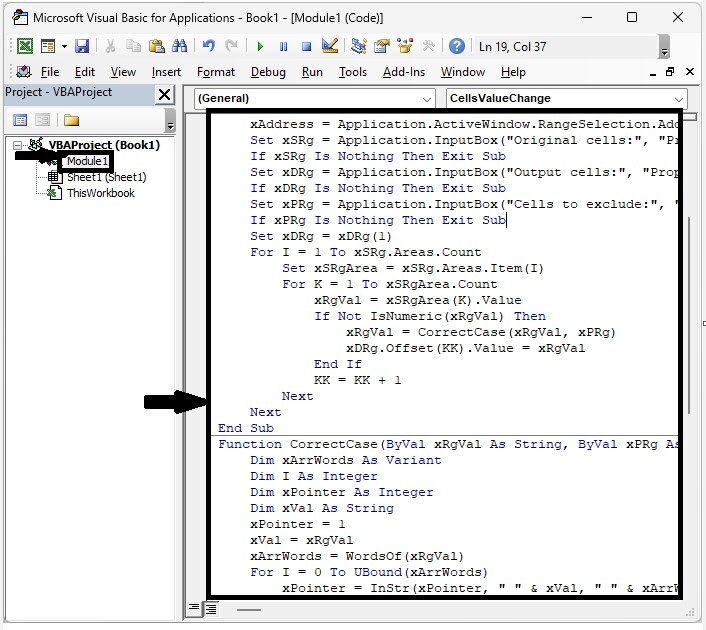
Step 3
Now save the sheet as a macro-enabled workbook and click F5 to run the code. Then select the range of original data and click OK.
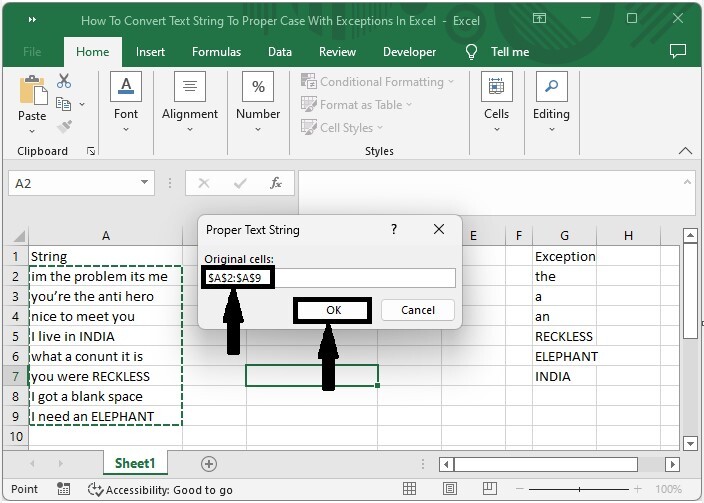
Step 4
Again, select the cells where you need the output and click OK.
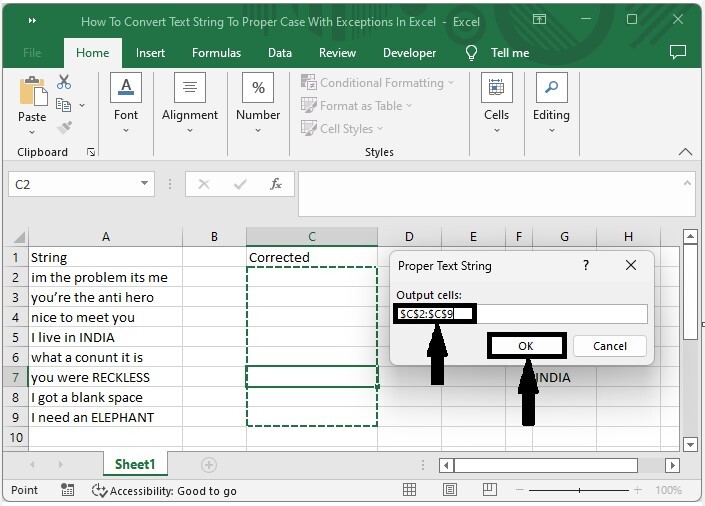
Step 4
Finally, select the range of exceptions and click OK.
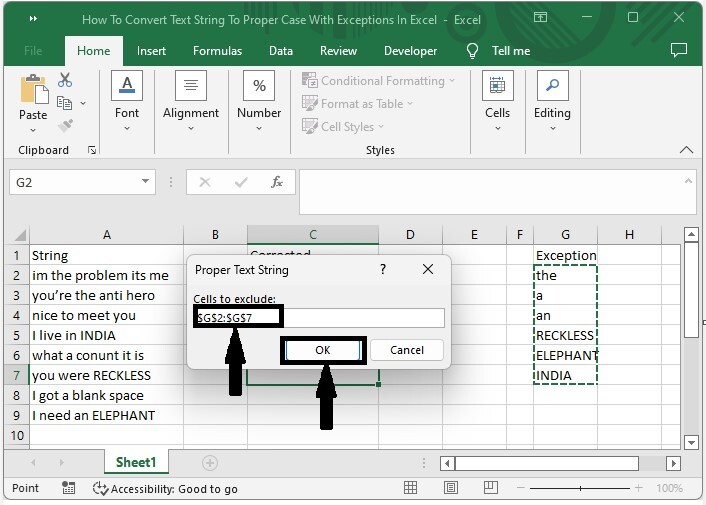
Conclusion
In this tutorial, we used a simple example to demonstrate how you can convert text strings to proper cases with exceptions in Excel.

